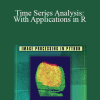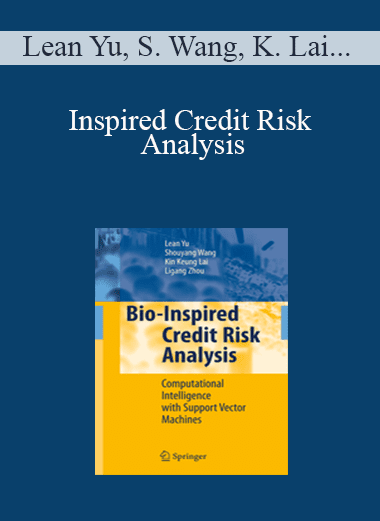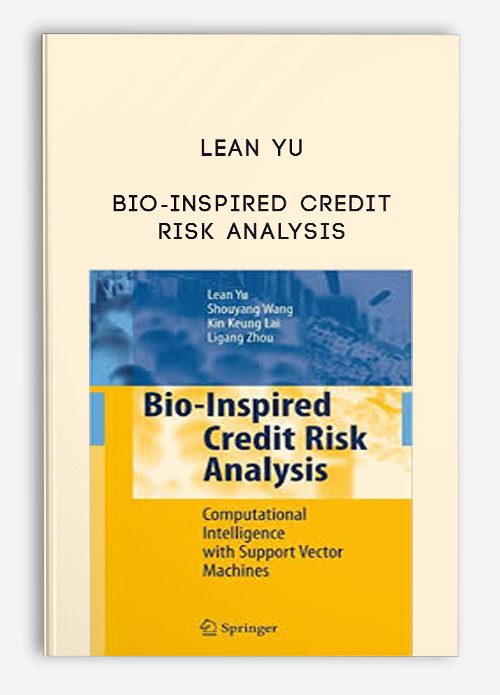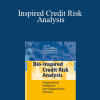Lean Yu, S. Wang, K. Lai, L. ZhoBio – Inspired Credit Risk Analysis
$125.00 Original price was: $125.00.$38.00Current price is: $38.00.
Digital Download: You will receive a download link via your order email
Credit risk analysis is one of the most important topics in the field of financial risk management. Due to recent financial crises and regulatory concern of Basel II, credit risk analysis has been the major focus of financial and banking industry…
Inspired Credit Risk Analysis
Computational Intelligence with Support Vector Machines
By: Lean Yu, Shouyang Wang, Kin Keung Lai, Ligang Zhou
Publisher: Springer; 1 edition (June 1, 2008)
Format: Ebook (PDF)
Description:
Credit risk analysis is one of the most important topics in the field of financial risk management. Due to recent financial crises and regulatory concern of Basel II, credit risk analysis has been the major focus of financial and banking industry. Especially for some credit-granting institutions such as commercial banks and credit companies, the ability to discriminate good customers from bad ones is crucial. The need for reliable quantitative models that predict defaults accurately is imperative so that the interested parties can take either preventive or corrective action. Hence credit risk analysis becomes very important for sustainability and profit of enterprises. In such backgrounds, this book tries to integrate recent emerging support vector machines and other computational intelligence techniques that replicate the principles of bio-inspired information processing to create some innovative methodologies for credit risk analysis and to provide decision support information for interested parties.
Table of Contents:
Part I
Credit Risk Analysis with Computational Intelligence:
An Analytical Survey……………………………………………………………………… 1
1 Credit Risk Analysis with Computational Intelligence: A Review….. 3
1.1 Introduction……………………………………………………………………………. 3
1.2 Literature Collection ……………………………………………………………….. 5
1.3 Literature Investigation and Analysis ………………………………………… 7
1.3.1 What is Credit Risk Evaluation Problem? ……………………………. 8
1.3.2 Typical Techniques for Credit Risk Analysis ……………………….. 8
1.3.3 Comparisons of Models …………………………………………………… 17
1.4 Implications on Valuable Research Topics……………………………….. 23
1.5 Conclusions………………………………………………………………………….. 24
Part II
Unitary SVM Models with Optimal Parameter Selection for Credit
Risk Evaluation……………………………………………………………………………. 25
2 Credit Risk Assessment Using a Nearest-Point-Algorithm-based
SVM with Design of Experiment for Parameter Selection………….. 27
2.1 Introduction………………………………………………………………………….. 27
2.2 SVM with Nearest Point Algorithm ………………………………………… 29
2.3 DOE-based Parameter Selection for SVM with NPA ………………… 33
2.4 Experimental Analysis…………………………………………………………… 35
2.5 Conclusions………………………………………………………………………….. 38
3 Credit Risk Evaluation Using SVM with Direct Search for Parameter
Selection ……………………………………………………………………………… 41
3.1 Introduction………………………………………………………………………….. 41
3.2 Methodology Description ………………………………………………………. 43
3.2.1 Brief Review of LSSVM …………………………………………………. 43
3.2.2 Direct Search for Parameter Selection……………………………….. 45
3.3 Experimental Study……………………………………………………………….. 47
3.3.1 Research Data ………………………………………………………………… 47
3.3.2 Parameter Selection with Genetic Algorithm ……………………… 48
3.3.3 Parameters Selection with Grid Search………………………………. 49
3.3.4 Experimental Results ………………………………………………………. 50
3.4 Conclusions…………………………………………………………………………..54
Part III
Hybridizing SVM and Other Computational Intelligent Techniques
for Credit Risk Analysis ……………………………………………………………….. 57
4 Hybridizing Rough Sets and SVM for Credit Risk Evaluation…….. 59
4.1 Introduction………………………………………………………………………….. 59
4.2 Preliminaries of Rough Sets and SVM …………………………………….. 61
4.2.1 Basic Concepts of Rough Sets ………………………………………….. 61
4.2.2 Basic Ideas of Support Vector Machines……………………………. 62
4.3 Proposed Hybrid Intelligent Mining System …………………………….. 63
4.3.1 General framework of Hybrid Intelligent Mining System……. 63
4.3.2 2D-Reductions by Rough Sets………………………………………….. 64
4.3.3 Feature Selection by SVM……………………………………………….. 65
4.3.4 Rule Generation by Rough Sets………………………………………… 66
4.3.5 General Procedure of the Hybrid Intelligent Mining System … 67
4.4 Experiment Study …………………………………………………………………. 68
4.4.1 Corporation Credit Dataset ………………………………………………. 69
4.4.2 Consumer Credit Dataset …………………………………………………. 70
4.5 Concluding Remarks……………………………………………………………… 72
5 A Least Squares Fuzzy SVM Approach to Credit Risk Assessment 73
5.1 Introduction………………………………………………………………………….. 73
5.2 Least Squares Fuzzy SVM……………………………………………………… 74
5.2.1 SVM……………………………………………………………………………… 74
5.2.2 FSVM …………………………………………………………………………… 77
5.2.3 Least Squares FSVM ………………………………………………………. 79
5.3 Experiment Analysis……………………………………………………………… 81
5.4 Conclusions………………………………………………………………………….. 84
6 Evaluating Credit Risk with a Bilateral-Weighted Fuzzy SVM
Model………………………………………………………………………………………. 85
6.1 Introduction………………………………………………………………………….. 85
6.2 Formulation of the Bilateral-Weighted Fuzzy SVM Model ………… 89
6.2.1 Bilateral-Weighting Errors ………………………………………………. 89
6.2.2 Formulation Process of the Bilateral-weighted fuzzy SVM….. 91
6.2.3 Generating Membership ………………………………………………….. 93
6.3 Empirical Analysis………………………………………………………………… 95
6.3.1 Dataset 1: UK Case…………………………………………………………. 96
6.3.2 Dataset 2: Japanese Case …………………………………………………. 98
6.3.3 Dataset 3: England Case …………………………………………………100
6.4 Conclusions…………………………………………………………………………102
7 Evolving Least Squares SVM for Credit Risk Analysis ………………105
7.1 Introduction…………………………………………………………………………105
7.2 SVM and LSSVM………………………………………………………………..108
7.3 Evolving LSSVM Learning Paradigm…………………………………….111
7.3.1 General framework of Evolving LSSVM Learning Method .111
7.3.2 GA-based Input Features Evolution………………………………….113
7.3.3 GA-based Parameters Evolution………………………………………117
7.4 Research Data and Comparable Models ………………………………….119
7.4.1 Research Data ……………………………………………………………….119
7.4.2 Overview of Other Comparable Classification Models……….121
7.5 Experimental Results ……………………………………………………………123
7.5.1 Empirical Analysis of GA-based Input Features Evolution….123
7.5.2 Empirical Analysis of GA-based Parameters Optimization …126
7.5.3 Comparisons with Other Classification Models …………………129
7.6 Conclusions…………………………………………………………………………131
Part IV
SVM Ensemble Learning for Credit Risk Analysis……………………….133
8 Credit Risk Evaluation Using a Multistage SVM Ensemble Learning
Approach…………………………………………………………………………………135
8.1 Introduction…………………………………………………………………………135
8.2 Previous Studies…………………………………………………………………..138
8.3 Formulation of SVM Ensemble Learning Paradigm …………………140
8.3.1 Partitioning Original Data Set………………………………………….140
8.3.2 Creating Diverse Neural Network Classifiers…………………….142
8.3.3 SVM Learning and Confidence Value Generation ……………..143
8.3.4 Selecting Appropriate Ensemble Members ……………………….144
8.3.5 Reliability Value Transformation …………………………………….146
8.3.6 Integrating Multiple Classifiers into an Ensemble Output……146
8.4 Empirical Analysis……………………………………………………………….148
8.4.1 Consumer Credit Risk Assessment…………………………………..149
8.4.2 Corporation Credit Risk Assessment ………………………………..151
8.5 Conclusions…………………………………………………………………………154
9 Credit Risk Analysis with a SVM-based metamodeling Ensemble
Approach…………………………………………………………………………………157
9.1 Introduction………………………………………………………………………… 157
9.2 SVM-based metamodeling Process……………………………………….. 160
9.2.1 A Generic metalearning Process …………………………………….. 160
9.2.2 An Extended metalearning Process …………………………………. 163
9.2.3 SVM-based metamodeling Process…………………………………. 165
9.3 Experimental Analyses ………………………………………………………… 173
9.3.1 Research Data and Experiment Design…………………………….. 173
9.3.2 Experimental Results …………………………………………………….. 174
9.4 Conclusions………………………………………………………………………… 177
10 An Evolutionary-Programming-Based Knowledge Ensemble Model
for Business Credit Risk Analysis …………………………………………… 179
10.1 Introduction………………………………………………………………………. 179
10.2 EP-Based Knowledge Ensemble Methodology ……………………… 181
10.2.1 Brief Introduction of Individual Data Mining Models ……… 182
10.2.2 Knowledge Ensemble based on Individual Mining Results . 185
10.3 Research Data and Experiment Design…………………………………. 188
10.4 Experiment Results ……………………………………………………………. 189
10.4.1 Results of Individual Models………………………………………… 189
10.4.2 Identification Performance of the Knowledge Ensemble ….. 191
10.4.3 Identification Performance Comparisons ……………………….. 193
10.5 Conclusions………………………………………………………………………. 195
11 An Intelligent-Agent-Based Multicriteria Fuzzy Group Decision
Making Model for Credit Risk Analysis…………………………………. 197
11.1 Introduction………………………………………………………………………. 197
11.2 Methodology Formulation ………………………………………………….. 201
11.3 Experimental Study……………………………………………………………. 206
11.3.1 An Illustrative Numerical Example ……………………………….. 206
11.3.2 Empirical Comparisons with Different Credit Datasets ……. 208
11.4 Conclusions and Future Directions………………………………………. 221
References………………………………………………………………………………….. 223
Subject Index……………………………………………………………………………… 239
Biographies of Four Authors of the Book…………………………………….. 243
Get Download Lean Yu, S. Wang, K. Lai, L. ZhoBio – Inspired Credit Risk Analysis at IMC.sale today!
Delivery Method
– After your purchase, you’ll see a View your orders link which goes to the Downloads page. Here, you can download all the files associated with your order.
– Downloads are available once your payment is confirmed, we’ll also send you a download notification email separate from any transaction notification emails you receive from IMC.sale.
– Since it is a digital copy, our suggestion is to download and save it to your hard drive. In case the link is broken for any reason, please contact us and we will resend the new download link.
– If you cannot find the download link, please don’t worry about that. We will update and notify you as soon as possible at 8:00 AM – 8:00 PM (UTC+8).
Thank You For Shopping With Us!
Be the first to review “Lean Yu, S. Wang, K. Lai, L. ZhoBio – Inspired Credit Risk Analysis” Cancel reply
Related Products
Forex & Trading






10 reviews for Lean Yu, S. Wang, K. Lai, L. ZhoBio – Inspired Credit Risk Analysis
There are no reviews yet.